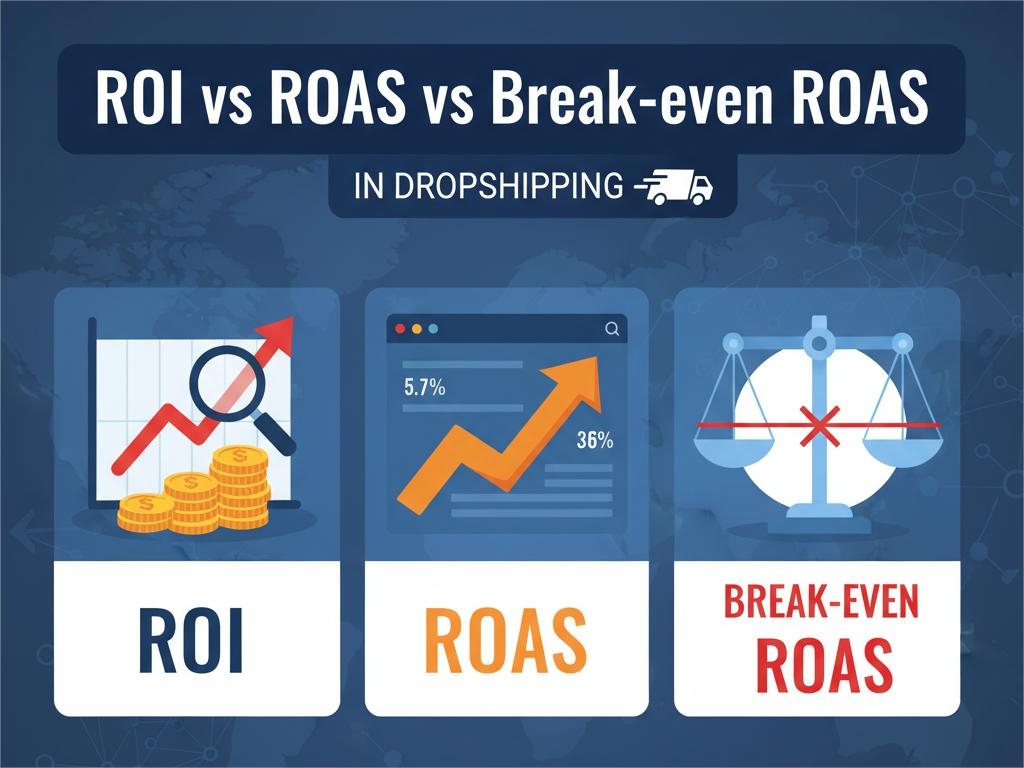Launch your dropshipping journey today – Your first sale is closer than you think!
- Home /
- Blog /
- Dropshipping /
- ROI vs ROAS vs Break-even ROAS in Dropshipping: What Every Seller Should Know
ROI vs ROAS vs Break-even ROAS in Dropshipping: What Every Seller Should Know
-
Charlie Shen
- Last updated: October 14, 2025
Copy Link
Facebook
X
WhatsApp
LinkedIn
Email

When running paid ads for your dropshipping store, it’s not enough to just track sales — you need to understand how efficiently your ad spend turns into profit.
That’s where ROI, ROAS, and Break-even ROAS come in. These three metrics reveal whether your campaigns are profitable, sustainable, or losing money.
Let’s break them down.
🧮 What Is ROI (Return on Investment)?
ROI measures the overall profitability of an investment — how much return you make compared to what you spend.
ROI Formula
\[ \text{ROI} = \frac{\text{Net Profit}}{\text{Investment}} \times 100\% \]
Example:
You spend $800 on product sourcing, marketing, and shipping, and generate $1,200 in revenue.
\[ \text{ROI} = \frac{1200 – 800}{800} \times 100 = 50\% \]
That means your business made a 50% return on investment.
👉 In dropshipping: ROI gives you the big picture of business profitability, combining ad costs, product expenses, and all operational fees.
📈 What Is ROAS (Return on Ad Spend)?
ROAS focuses specifically on your advertising efficiency. It tells you how much revenue you earn for every dollar spent on ads.
ROAS Formula
\[ \mathrm{ROAS} = \frac{\text{Revenue}}{\text{Ad Spend}} \]
Example:
You spend $100 on ads and generate $400 in sales.
\[ \text{ROAS} = \frac{400}{100} = 4 \]
This means for every $1 you spend, you earn $4 in revenue — a 4.0 ROAS.
👉 In dropshipping: ROAS is a quick way to judge whether your ad campaigns are performing well. Higher ROAS = more efficient advertising.
💡 What Is Break-even ROAS?
Even if your ROAS looks high, it doesn’t always mean you’re profitable — because you still have product costs, shipping fees, and platform fees to cover.
That’s why dropshippers use Break-even ROAS, which shows the minimum ROAS you need to avoid losing money.
Break-even ROAS Formula
\[ \text{Break-even ROAS} = \frac{\text{Selling Price}}{\text{Selling Price} – \text{Non-ad Costs}} \]
Where:
- Selling Price = retail price of your product
- Non-ad Costs = product cost, shipping, transaction fees, packaging, etc.
Example:
Selling Price = $39.99
Non-ad Costs = $19.45
\[ \text{Break-even ROAS} = \frac{39.99}{39.99 – 19.45} \approx 1.95 \]
So if your ad campaign delivers less than a 1.95 ROAS, you’re losing money.
👉 In dropshipping: Knowing your break-even ROAS helps you decide whether to scale, optimize, or stop a campaign.
🚀 Why These Metrics Matter for Dropshippers
| Metric | Measures | Focus | Purpose |
|---|---|---|---|
| ROI | Overall profitability | Business-wide | See total returns after all costs |
| ROAS | Ad performance | Marketing efficiency | Compare campaigns or platforms |
| Break-even ROAS | Profit threshold | Risk management | Know when ads stop being profitable |
Understanding all three helps you:
- Make data-driven decisions instead of guessing
- Set smarter ad budgets
- Find your target selling price
- Avoid scaling unprofitable campaigns
🧭 Final Thoughts
In dropshipping, success isn’t just about selling more — it’s about selling profitably.
Tracking ROI, ROAS, and Break-even ROAS gives you a clear roadmap to sustainable growth.
👉 Use our Free Dropshipping Calculator for Break-even ROAS, ROI to test your numbers before you launch your next ad campaign.
Small tweaks in product cost, shipping, or ad spend can mean the difference between profit and loss.
FAQ
What is a good ROAS for dropshipping?
A good ROAS depends on your profit margins and costs. In general, a ROAS of 3–4 is considered average, while 5+ is excellent. However, if your costs are high, your break-even ROAS might already be around 3–4.
How do I calculate the Break-even ROAS if I know the profit margin?
If you already know your profit margin, simply take the inverse of it:
\[ Break\text{-}even\ ROAS = \frac{1}{Profit\ Margin} \]
Example:
If your profit margin is 25% (or 0.25), then:
\[ Break\text{-}even\ ROAS = \frac{1}{0.25} = 4 \]
This means your ads need a ROAS of 4.0 just to break even — anything higher is profit.Why is my ROAS high but ROI low?
Because ROAS only measures ad performance, not total costs.
Even if your ads are efficient, other expenses (like product cost, shipping, and fees) can reduce your overall ROI.How can I improve my ROI and ROAS?
(1) Negotiate lower supplier or shipping costs
(2) Optimize ad targeting to reduce cost per purchase (CPA)
(3) Increase average order value (AOV) with bundles or upsells
(4) Use email marketing or retargeting for cheaper conversions
Table of Contents



